ByteBuf简单介绍
其实是一个接口,但是有很多方法,可以理解成一个缓冲区数组,有一些操作的索引,比如读索引readerIndex表示从这个索引开始读,写索引writerIndex表示从这个索引开始写,还有缓冲区容量capacity等等。先看下类结构:
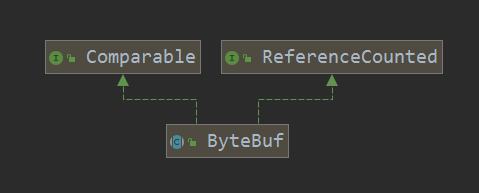
有一个引用计数的接口,因为缓冲区用完了需要释放,这里用引用计数来管理。
其实缓冲区大致是这么个样子:
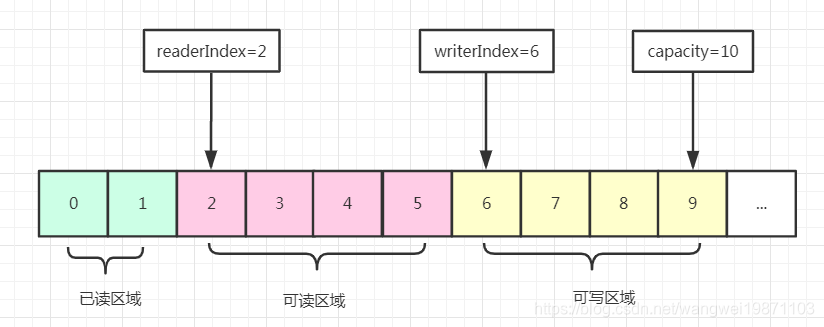
一些特定的操作
discardReadBytes
把已读的区域数据给丢弃掉,其实就是把这部分区域给回收了,把读写索引都往前移,可写区域就大了:
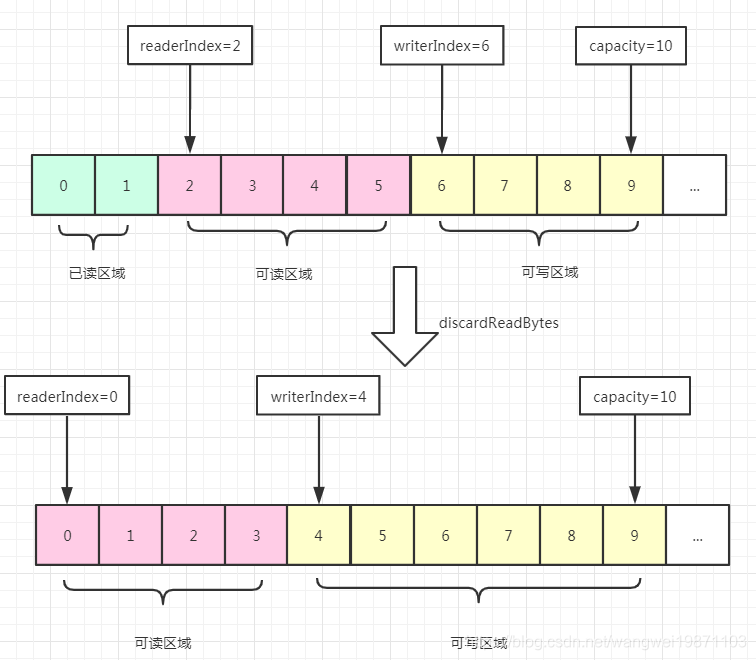
clear
这个并不是清除数据,只是重置读写索引到0,可写区域又变大了:
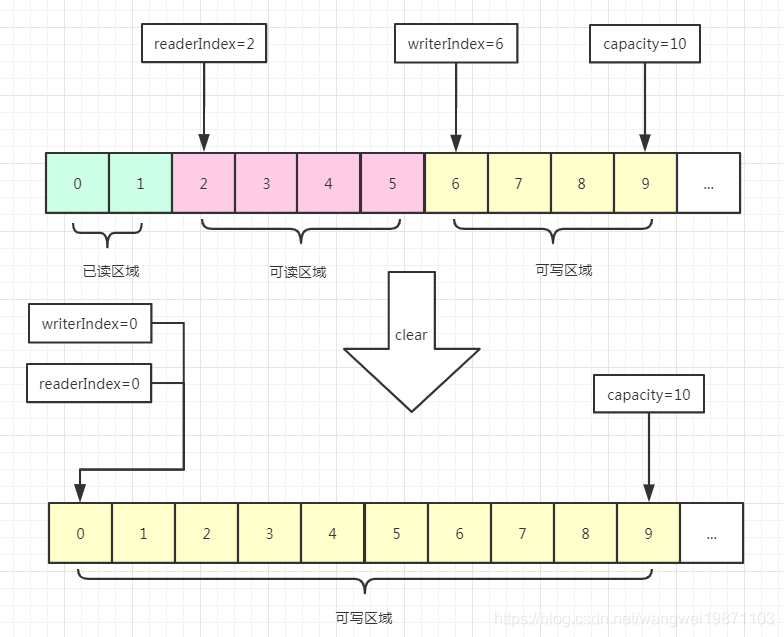
其实方法有很多,一些不太好用图表示,后面会慢慢讲解的。
AbstractByteBuf
这个抽象字节缓冲区对ByteBuf的接口方法做了一些基本的实现。
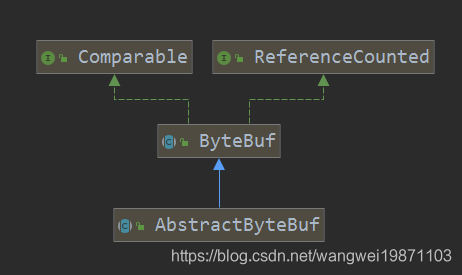
具体的实现都比较好理解,就不多说了,但是有一个要注意,就是他里面有个泄露检测器,应该是用来帮助检测内存泄露的,后面会说:

ReferenceCounted引用计数接口
这个就是为了更好的管理好内存用的一种比较简单的方法,简单的原理就是如果一个对象有引用,那就计数器+1,如果释放了引用,那就计数器-1,如果发现计数器是0了,那就执行回收。一般的堆内的内存可以由GC来回收,但是如果是堆外的话,就要自己手动来释放啦,不然会造成内存泄露的。touch方法就是辅助调试用的,另外就是引用计数增加retain和减少release。

AbstractReferenceCountedByteBuf
这个字节缓冲区没干别的什么主要就是实现了引用计数器接口:

我们来看看源码,其实都是调用了ReferenceCountUpdater的方法。
public abstract class AbstractReferenceCountedByteBuf extends AbstractByteBuf {
private static final long REFCNT_FIELD_OFFSET =//refCnt属性的内存偏移地址
ReferenceCountUpdater.getUnsafeOffset(AbstractReferenceCountedByteBuf.class, "refCnt");
private static final AtomicIntegerFieldUpdater<AbstractReferenceCountedByteBuf> AIF_UPDATER =//原子更新器
AtomicIntegerFieldUpdater.newUpdater(AbstractReferenceCountedByteBuf.class, "refCnt");
//引用更新器
private static final ReferenceCountUpdater<AbstractReferenceCountedByteBuf> updater =
new ReferenceCountUpdater<AbstractReferenceCountedByteBuf>() {
@Override
protected AtomicIntegerFieldUpdater<AbstractReferenceCountedByteBuf> updater() {
return AIF_UPDATER;
}
@Override
protected long unsafeOffset() {
return REFCNT_FIELD_OFFSET;
}
};
// Value might not equal "real" reference count, all access should be via the updater 初始值
@SuppressWarnings("unused")
private volatile int refCnt = updater.initialValue();
protected AbstractReferenceCountedByteBuf(int maxCapacity) {
super(maxCapacity);
}
@Override
boolean isAccessible() {
// Try to do non-volatile read for performance as the ensureAccessible() is racy anyway and only provide
// a best-effort guard.
return updater.isLiveNonVolatile(this);//是否还能用,释放了就不能用了
}
@Override
public int refCnt() {
return updater.refCnt(this);//获取真实引用计数
}
/** 直接设置真实引用计数
* An unsafe operation intended for use by a subclass that sets the reference count of the buffer directly
*/
protected final void setRefCnt(int refCnt) {
updater.setRefCnt(this, refCnt);
}
/** 重新设置真实计数
* An unsafe operation intended for use by a subclass that resets the reference count of the buffer to 1
*/
protected final void resetRefCnt() {
updater.resetRefCnt(this);
}
//真实计数+1
@Override
public ByteBuf retain() {
return updater.retain(this);
}
//真实计数+increment
@Override
public ByteBuf retain(int increment) {
return updater.retain(this, increment);
}
//获取当前对象
@Override
public ByteBuf touch() {
return this;
}
@Override
public ByteBuf touch(Object hint) {
return this;
}
//外部可以调用的尝试释放资源,内部是用引用更新器来判断的
@Override
public boolean release() {
return handleRelease(updater.release(this));
}
@Override
public boolean release(int decrement) {
return handleRelease(updater.release(this, decrement));
}
//真正返回才去释放
private boolean handleRelease(boolean result) {
if (result) {
deallocate();
}
return result;
}
/** 一旦真实计数为0就释放资源
* Called once {@link #refCnt()} is equals 0.
*/
protected abstract void deallocate();
}
ReferenceCountUpdater
具体引用计数怎么实现的,主要是这个类。但是他并不是用普通的那种引用一次计数器加1,释放一次减1,而是用了奇数和偶数,如果还存在引用那么引用数是偶数,否则是奇数。同时引用一次会加2,释放一次也减2,获取真实的计数是引用计数无符号右移1位,看起来好像很奇怪,不过基本都是位操作和直接比较操作性能应该会提高点。比如我们初始的时候真实引用计数=1,但是内部引用计数=2。如果有一次释放就内部引用计数-2,两次就内部引用计数-4,当然引用的时候也一样,你会发现 只要有引用,内部引用计数值就是偶数 。我们举个例子,我引用了3次,内部引用计数=6,获取真实引用计数刚好6>>>1=3,如果释放了3次,前2次会将内部引用计数=2,但是最后一次如果发现内部引用计数=2的话,就会设置成1, 这样内部引用计数刚好是奇数,真实引用计数刚好是1>>>1=0,就可以释放内存了 。说了那么多,还是看源码吧,里面有体现。
realRefCnt
这个就是获取真实的计数,是引用计数>>>1,同时前面会判断引用计数是否是偶数,偶数才有引用,奇数就直接返回0了,这里开始并不是直接用&判断奇偶,而是直接用是否等于,这个比位操作更加快,可见netty在这提高性能方面真的做到了细节中的细节了,因为大部分真实的计数可能就是1或者2,所以前面两个只要直接判断相等即可:
//获得真实计数 引用计数是奇数就返回0,说明已经释放了 偶数就无符号右移1 返回
private static int realRefCnt(int rawCnt) {
return rawCnt != 2 && rawCnt != 4 && (rawCnt & 1) != 0 ? 0 : rawCnt >>> 1;
}
toLiveRealRefCnt
这个主要是在释放的时候内部用的,如果真实计数已经是0了,再释放就会报错,避免重复释放。
/** 获取真实计数,如果真实引用已经是0了,就抛异常
* Like {@link #realRefCnt(int)} but throws if refCnt == 0
*/
private static int toLiveRealRefCnt(int rawCnt, int decrement) {
if (rawCnt == 2 || rawCnt == 4 || (rawCnt & 1) == 0) {
return rawCnt >>> 1;//偶数就无符号右移1
}
// odd rawCnt => already deallocated 奇数已经释放的
throw new IllegalReferenceCountException(0, -decrement);
}
refCnt
获取真实计数,但是不会抛异常。
//获取真实计数
public final int refCnt(T instance) {
return realRefCnt(updater().get(instance));
}
nonVolatileRawCnt
这个可以获取内部的引用计数,不是真实的。
//可以根据偏移量获得引用计数,不是真实的计数
private int nonVolatileRawCnt(T instance) {
// TODO: Once we compile against later versions of Java we can replace the Unsafe usage here by varhandles.
final long offset = unsafeOffset();
return offset != -1 ? PlatformDependent.getInt(instance, offset) : updater().get(instance);
}
isLiveNonVolatile
这个就是判断是否还存在引用,即内部的引用是否是偶数,是的话表示还有引用计数,返回true,不是就表示释放了,返回false,最后也是先判断是否相等来优化。
//是否是还有真实计数
public final boolean isLiveNonVolatile(T instance) {
final long offset = unsafeOffset();
final int rawCnt = offset != -1 ? PlatformDependent.getInt(instance, offset) : updater().get(instance);
// The "real" ref count is > 0 if the rawCnt is even.偶数的话真实计数>0
return rawCnt == 2 || rawCnt == 4 || rawCnt == 6 || rawCnt == 8 || (rawCnt & 1) == 0;
}
setRefCnt
直接设置真实引用计数,可以看到如果正数就会乘以2,负数就直接是1,也就是说没设置成功。但是这里要注意refCnt << 1可能会是负数,溢出了,比如1173741824<<1 =-1947483648。
public final void setRefCnt(T instance, int refCnt) {
updater().set(instance, refCnt > 0 ? refCnt << 1 : 1); // overflow OK here
}
retain
这几个方法都是增加引用的,里面会判断溢出的问题。
//真实计数+1,即引用计数+2
public final T retain(T instance) {
return retain0(instance, 1, 2);
}
//increment为正的才可以,但是rawIncrement 可能是负的,溢出了,后面会处理
public final T retain(T instance, int increment) {
// all changes to the raw count are 2x the "real" change - overflow is OK
int rawIncrement = checkPositive(increment, "increment") << 1;
return retain0(instance, increment, rawIncrement);
}
// rawIncrement == increment << 1 增量=真实增量x2
private T retain0(T instance, final int increment, final int rawIncrement) {
int oldRef = updater().getAndAdd(instance, rawIncrement);
if (oldRef != 2 && oldRef != 4 && (oldRef & 1) != 0) {//如果老的是奇数的话 说明已经释放了
throw new IllegalReferenceCountException(0, increment);
}
// don't pass 0! 经过0就说明有溢出了,要处理掉
if ((oldRef <= 0 && oldRef + rawIncrement >= 0)//比如setRefCnt的时候设置了负数进去,oldRef =-1173741824,increment=1003741824 rawIncrement=2007483648
|| (oldRef >= 0 && oldRef + rawIncrement < oldRef)) {//比如setRefCnt的时候设置了正数进去,oldRef =2,increment=1103741824 rawIncrement=-2087483648
// overflow case 溢出了
updater().getAndAdd(instance, -rawIncrement);//改回来
throw new IllegalReferenceCountException(realRefCnt(oldRef), increment);
}
return instance;
}
release
释放的时候会先调用nonVolatileRawCnt获得引用计数,然后判断引用计数是否是2或者减的值就是真实引用计数值,是的话就可以尝试直接设置的方法tryFinalRelease0,如果失败会去尝试释放方法retryRelease0,这个是自旋,直到成功为止。如果不是的话就普通的引用计数器值的修改即可nonFinalRelease0。当然这里可能会对引用已经是1的再进行释放,这样就会在retryRelease0中的toLiveRealRefCnt检测报异常,避免了重复释放,而且里面修改值都是原子操作,线程安全的。
//减少计数1,返回是否真正释放
public final boolean release(T instance) {
int rawCnt = nonVolatileRawCnt(instance);//获取引用计数 如果引用计数rawCnt == 2 说明真实计数是1,就可以直接尝试最终释放,否则就真实计数减1,这个就算已经释放也不会报错
return rawCnt == 2 ? tryFinalRelease0(instance, 2) || retryRelease0(instance, 1)
: nonFinalRelease0(instance, 1, rawCnt, toLiveRealRefCnt(rawCnt, 1));
}
//减少计数decrement,返回是否真正释放
public final boolean release(T instance, int decrement) {
int rawCnt = nonVolatileRawCnt(instance);//获取引用计数
int realCnt = toLiveRealRefCnt(rawCnt, checkPositive(decrement, "decrement"));//获取真实计数
return decrement == realCnt ? tryFinalRelease0(instance, rawCnt) || retryRelease0(instance, decrement)
: nonFinalRelease0(instance, decrement, rawCnt, realCnt);//
}
//尝试最终释放 如果引用计数是2的话,就直接设为1,释放内存,否则就失败
private boolean tryFinalRelease0(T instance, int expectRawCnt) {
return updater().compareAndSet(instance, expectRawCnt, 1); // any odd number will work
}
private boolean nonFinalRelease0(T instance, int decrement, int rawCnt, int realCnt) {
if (decrement < realCnt //更新引用计数
// all changes to the raw count are 2x the "real" change - overflow is OK
&& updater().compareAndSet(instance, rawCnt, rawCnt - (decrement << 1))) {
return false;
}
return retryRelease0(instance, decrement);
}
//自旋设置引用计数或者尝试释放
private boolean retryRelease0(T instance, int decrement) {
for (;;) {
int rawCnt = updater().get(instance), realCnt = toLiveRealRefCnt(rawCnt, decrement);
if (decrement == realCnt) {//真实的计数和要减去的计数一样的话
if (tryFinalRelease0(instance, rawCnt)) {//尝试最终释放
return true;
}
} else if (decrement < realCnt) {//真实计数大于减去的计数,还不能释放,只是减去decrement
// all changes to the raw count are 2x the "real" change
if (updater().compareAndSet(instance, rawCnt, rawCnt - (decrement << 1))) {
return false;
}
} else {
throw new IllegalReferenceCountException(realCnt, -decrement);
}
Thread.yield(); // this benefits throughput under high contention 提示释放CPU,增加吞吐量
}
}
总结
今天主要先讲下这个引用计数缓冲区的实现,后面很多我们常用的缓冲区都是这个的子类:
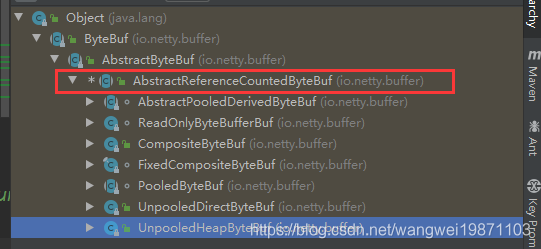
其他的后面再讲吧,现在我们知道了很多缓冲区是实现引用计数接口的就行了,主要还是要释放内存,特别是堆外的内存。
好了,今天就到这里了,希望对学习理解有帮助,大神看见勿喷,仅为自己的学习理解,能力有限,请多包涵。
Java 面试宝典是大明哥全力打造的 Java 精品面试题,它是一份靠谱、强大、详细、经典的 Java 后端面试宝典。它不仅仅只是一道道面试题,而是一套完整的 Java 知识体系,一套你 Java 知识点的扫盲贴。
它的内容包括:
- 大厂真题:Java 面试宝典里面的题目都是最近几年的高频的大厂面试真题。
- 原创内容:Java 面试宝典内容全部都是大明哥原创,内容全面且通俗易懂,回答部分可以直接作为面试回答内容。
- 持续更新:一次购买,永久有效。大明哥会持续更新 3+ 年,累计更新 1000+,宝典会不断迭代更新,保证最新、最全面。
- 覆盖全面:本宝典累计更新 1000+,从 Java 入门到 Java 架构的高频面试题,实现 360° 全覆盖。
- 不止面试:内容包含面试题解析、内容详解、知识扩展,它不仅仅只是一份面试题,更是一套完整的 Java 知识体系。
- 宝典详情:https://www.yuque.com/chenssy/sike-java/xvlo920axlp7sf4k
- 宝典总览:https://www.yuque.com/chenssy/sike-java/yogsehzntzgp4ly1
- 宝典进展:https://www.yuque.com/chenssy/sike-java/en9ned7loo47z5aw
目前 Java 面试宝典累计更新 400+ 道,总字数 42w+。大明哥还在持续更新中,下图是大明哥在 2024-12 月份的更新情况:

想了解详情的小伙伴,扫描下面二维码加大明哥微信【daming091】咨询

同时,大明哥也整理一套目前市面最常见的热点面试题。微信搜[大明哥聊 Java]或扫描下方二维码关注大明哥的原创公众号[大明哥聊 Java] ,回复【面试题】 即可免费领取。

